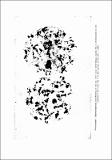Por favor, use este identificador para citar o enlazar a este item:
http://hdl.handle.net/10261/37109COMPARTIR / EXPORTAR:
 SHARE
BASE SHARE
BASE
|
|
| Visualizar otros formatos: MARC | Dublin Core | RDF | ORE | MODS | METS | DIDL | DATACITE | |

| Título: | Note on the sex chromosomes of the rat during male meiosis |
Autor: | Tjio, Joe Hin CSIC; Levan, Albert | Fecha de publicación: | 1956 | Editor: | CSIC - Estación Experimental de Aula Dei (EEAD) | Citación: | An. Estac. Exp. Aula Dei 4 (3-4): 174-184 (1956) | Resumen: | [EN] The behaviour of the sex chromosomes has been folowed through meiosis of the male rat. The development of the XY bivalent as a sex vesicle during meiotic prophase was studied. At metaphase I the X and Y are joined at their centromeric ends without any visible chiasma formation. No interstitial chiasmata were ever seen in the sex bivalent, nor the equational mode of separation expected from such chiasmata.
The consequence of this behaviour for crossing-over within the sex bivalent was discussed. The heteropycnotic development of the sex chromomes is dependent on the tissue studied: both X and Y were heteropycnotic during meiosis, Y was heteropycnotic in the spermatogonial divisions, neither of them was heteropycnotic in liver tissue. [ES] Se estudia el comportamiento de los cromosomas sexuales durante la meiosis de la rata macho. También se estudia el desarrollo del bivalente XY, como vesícua sexual durante la profase meiótica. Los cromosomas X e Y, en metafase I, se unen por sus extremos centroméricos, sin formación visible de quiasma. No se vieron quiasmas intersticiales en el bivalente sexual, ni tampoco se observó el modo de separación ecuacional que podría esperarse si existieran tales quiasmas. Se discuten las consecuencias que supone esta conducta para el sobrecruzamiento dentro del bivalente sexual. El desarrollo heteropicnótico de los cromosomas sexuales depende del tejido estudiado. Tanto el X como el Y son heteropicnóticos durante la meiosis; el Y lo es también en las divisiones espermatogónicas y ninguno de ellos lo es en tejido hepático. |
URI: | http://hdl.handle.net/10261/37109 | ISSN: | 0365-1899 |
| Aparece en las colecciones: | (EEAD) Artículos |
Ficheros en este ítem:
| Fichero | Descripción | Tamaño | Formato | |
|---|---|---|---|---|
| Páginas desdeVOL.4 3-4 Tjio 4-16.pdf | 523,19 kB | Adobe PDF |  Visualizar/Abrir |
CORE Recommender
Page view(s)
651
checked on 19-abr-2024
Download(s)
165
checked on 19-abr-2024
Google ScholarTM
Check
NOTA: Los ítems de Digital.CSIC están protegidos por copyright, con todos los derechos reservados, a menos que se indique lo contrario.
